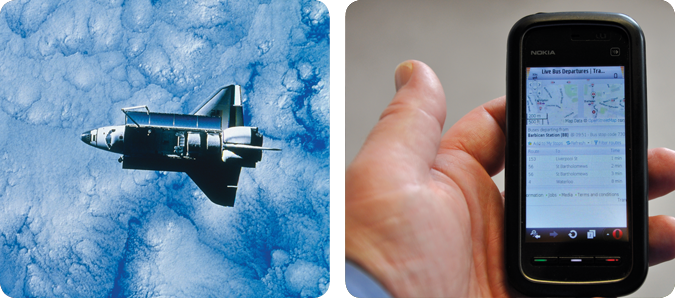
Technology
Introduction
The development of technology has had a great influence on travel especially in the last 150 years. Steam, the internal combustion engine, diesel and electricity, the jet engine and supersonic technology have increasingly provided faster and more comfortable travel opportunities to ever wider numbers of people.
Technology has also enabled a move towards customized travel. The offer is no longer “any car as long as it’s a black Model T” but travel customized by mode, time, cost and design.
More recently electronic technology has offered a substitute to physical travel as a result of the internet and associated social networking in real time.
Under some circumstances, a technology incorporates the values of the society for which it was invented to such a degree that these values become dominant in every society which applies that technology. High-energy technology, at least as applied to traffic, provides a clear example. High speed is the critical factor which makes transportation socially destructive. Participatory democracy demands low-energy technology, and free people must travel the road to productive social relations at the speed of a bicycle.
Ivan Illich, Energy and Equity (1973)
Key Aspects
The Cocoon Effect
- Technology has resulted in the separation of travellers from their surroundings. Distances previously involving several days’ journey can now be covered in a few hours at an astonishing pace. Rebecca Solnit argues in River of Shadows that this represents a shift in the way humans conceive of themselves in relation to their surroundings, removing us from a close relationship with the Earth, seasons and cyclical understandings and into a modern, linear approach to the world and technological/industrial progress. In contrast many people have embraced the new opportunities with enthusiasm and seem to have no problem in adjusting to new time zones, cultures and climates and positively relish the experience.
Technology as a substitute for travel
- The internet and telecommunications revolution of the past 20 years presents a further leap in our conceptualization of space and distance; instant communication across the world in different media, and a sense of connection across vast distances (‘virtual mobility’). When we can see each other and speak across continents for free, travel itself may be re-conceived away from necessary function and towards leisure.
Hyper-mobility
- Technological changes have enabled the increased availability of long distance travel, which has led to the phenomenon of ‘hypermobility’. Academics Cohen and Gössling describe some of the possible ‘darker sides’ of hypermobillity, which range from jet-lag, radiation and infectious disease exposure to negative impacts on home-based family and social life, stress and loneliness, perhaps resulting in increased likelihood of psychological disorders. Certainly one negative impact is on the environment. Transport as a whole makes up around 15% of global carbon emissions and whilst aviation and high-speed rail are only small parts of this (approximately 2% of global carbon emissions), they are growing fast: more people are travelling and, importantly, those who are already very mobile are becoming increasingly so.
Hailed for its beauty as well as its speed, Concorde seemed to belong less to the modern world than to the future. During 27 years of commercial service from 1976 to 2003, it became one of the best-loved engineering design projects of the 20th century. An exemplar of technological excellence, Concorde struck such a strong emotional chord with the public that children cheered whenever they spotted it in the sky.
The Design Museum (2006)
Practical Implications
- Disillusionment with some of the negative effects of technology has spawned the Appropriate Technology movement with some advocating that low energy and slower forms of travel are preferable for health, the environment, safety and well being. An alternative reaction is the development of lower emission travel technologies which have allowed many to justify continued travel in the face of concerns about the negative effects of carbon emissions.
- High Speed Technology has facilitated the mega-commute: Pan-European commuters can travel weekly or even daily across national borders, for example English commuters living in Calais (as encouraged at one point by Kent CC and Eurotunnel) and cheap air fares have resulted in a huge increase in second home ownership.
- One of the most beneficial aspects of technology is its role in enabling people with disabilities to travel. A wealth of features such as vehicle and infrastructure design, information systems and booking technology has liberated many disabled people previously confined and denied travel opportunities.
Further Reading/Resources
E.F. Schumacher, Small is Beautiful (1973)
Ranked by the Times Literary Supplement as among the 100 most influential books since WW2. It is often used to champion small, appropriate technologies that are believed to empower people more, in contrast with phrases such as “bigger is better”.
John Adams, ‘The Social Implications of Hypermobility’ in Proceedings from the Ottawa Workshop, OECD (2000).
Intelligent exploration of the benefits and costs of hypermobility.
Glenn Lyons, ‘Future mobility – it’s about time’, presented at the Universities Transport Study Group Conference, Loughborough, January 2003
Key Questions
Has the development of faster and more comfortable forms of transport enabled people to enrich their lives by compartmentalising their activities?
Can more efficient transport technologies enable more sustainable travel?
Will communications technologies reduce travel by substitution or help to unlock latent demand?

